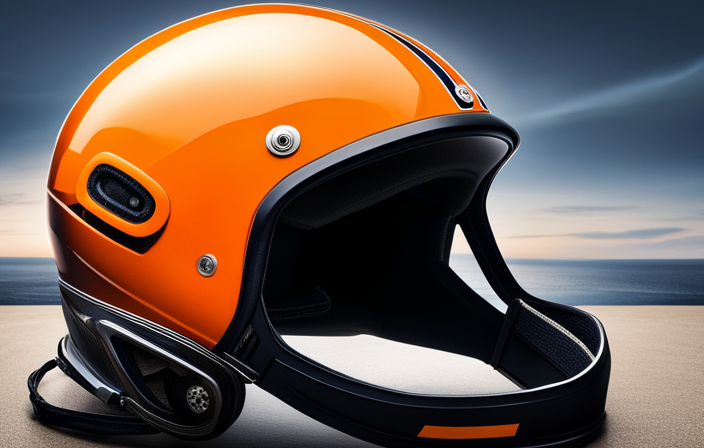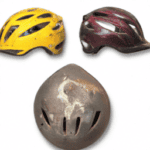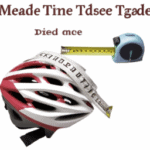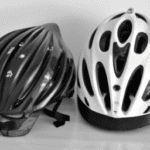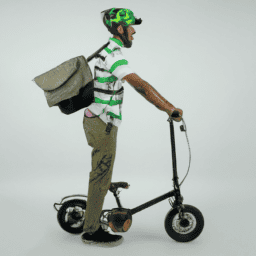It might cross your mind that buying a bicycle helmet is a one-time task, believing that it’s going to serve you forever. It’s merely a straightforward piece of safety equipment, isn’t it?
Well, think again. The lifespan of a bicycle helmet is not as long as you might expect. In fact, there are several factors that can impact its durability and effectiveness over time.
In this article, we will explore the important question of how long a bicycle helmet actually lasts, as well as provide valuable insights on when and why you should replace it.
So, buckle up (or rather, strap on your helmet) as we delve into the world of helmet safety and maintenance.
Key Takeaways
- The typical lifespan of a bicycle helmet is around five years, but it can vary based on factors such as frequency of use, intensity of impact, and exposure to sunlight and chemicals.
- Regular inspection and maintenance can help prolong the lifespan of a helmet.
- It is important to replace a helmet if it has been involved in a crash or shows signs of damage like cracks or dents.
- Following the manufacturer’s recommendations and proper care and maintenance, such as regular cleaning and storing in a cool, dry place, can help ensure the longevity of a helmet.
Understanding the Lifespan of a Bicycle Helmet
A bicycle helmet typically lasts for about five years. This lifespan is based on the general guidelines provided by helmet manufacturers and safety organizations.
However, it’s important to note that the actual lifespan of a helmet can vary depending on several factors. Helmet durability is influenced by factors such as the frequency of use, the intensity of impact, and exposure to sunlight and chemicals.
Regular inspection and maintenance can help prolong the lifespan of a helmet. It’s recommended to replace a helmet if it has been involved in a crash or if it shows signs of damage, such as cracks or dents.
Understanding the helmet lifespan and factors that impact helmet durability is crucial for ensuring the safety of cyclists.
Now, let’s explore the various factors that can affect the durability of a bicycle helmet.
Factors That Impact Helmet Durability
Factors such as frequency of use, maintenance, and the intensity of impacts can impact how long a bicycle helmet remains durable.
Helmet durability is influenced by various factors, including impact testing and material quality. Impact testing involves subjecting the helmet to simulated impacts to assess its ability to protect the head. Helmets that pass these tests are more likely to have a longer lifespan.
Additionally, the quality of materials used in the helmet construction plays a crucial role in its durability. High-quality materials are more resistant to wear and tear, ensuring the helmet can withstand regular use and impacts.
Understanding these factors is essential for ensuring the longevity of your helmet and maintaining optimal safety.
Now, let’s move on to the next section, where we will discuss the signs of helmet wear and tear.
Signs of Helmet Wear and Tear
To identify signs of wear and tear on your helmet, you should regularly inspect it for any visible cracks or dents that may compromise its effectiveness in protecting your head. These signs are crucial indicators that your helmet may no longer provide adequate protection.
Additionally, look out for any fraying or loosening of the straps, as well as any significant discoloration or fading of the outer shell. Any of these signs can indicate that your helmet has sustained damage and may need to be replaced.
Remember, the integrity of your helmet is vital for your safety, so it’s important to address any signs of wear and tear promptly. With that said, understanding the signs of helmet wear and tear is essential in determining the recommended helmet replacement timeline.
Recommended Helmet Replacement Timeline
Inspect your helmet regularly to ensure it remains in good condition and replace it as recommended to maintain optimal protection. Understanding the helmet lifespan and following the recommended replacement timeline is crucial for your safety. While helmets are designed to withstand impacts, they can degrade over time due to wear and tear. The table below outlines the general guidelines for helmet replacement based on different factors such as usage frequency, impact history, and exposure to extreme temperatures:
| Usage Frequency | Impact History | Exposure to Extreme Temperatures | Helmet Lifespan |
|---|---|---|---|
| Regular | None | None | 3-5 years |
| Regular | Minor | None | 3-5 years |
| Regular | Major | None | Replace |
| Regular | None | Frequent | 2-3 years |
| Regular | Minor | Frequent | 2-3 years |
Remember, these are general guidelines, and it’s important to follow the manufacturer’s recommendations for your specific helmet. Now let’s delve into proper helmet care and maintenance to ensure its longevity and effectiveness.
Proper Helmet Care and Maintenance
Take care of your helmet by regularly cleaning and storing it properly to ensure its durability and effectiveness. Here are four important tips for maintaining your helmet:
-
Clean the helmet regularly: Use a mild soap and water solution to gently clean the outer shell and straps. Avoid using harsh chemicals or solvents as they can damage the helmet’s materials.
-
Remove sweat and odor: After each ride, wipe the inside of the helmet with a soft cloth or sponge to remove sweat and prevent unpleasant odors. You can also use a helmet deodorizer spray for additional freshness.
-
Store in a cool, dry place: Avoid leaving your helmet in direct sunlight or extreme temperatures as it can degrade the materials and compromise its protective capabilities. Store it in a well-ventilated area to prevent moisture buildup.
-
Handle with care: Avoid dropping or banging your helmet as it can weaken its structure. Treat it gently and avoid storing heavy objects on top of it.
Ensuring proper helmet care and storage is essential for maintaining its longevity and effectiveness.
Now, let’s discuss the importance of a properly fitted helmet.
Importance of a Properly Fitted Helmet
Make sure your helmet fits properly to maximize its safety and protection. Proper helmet fitting techniques are essential for ensuring that your helmet can effectively protect your head in the event of a crash or fall.
A properly fitted helmet should sit level on your head, with the front edge just above your eyebrows. It should be snug but not too tight, and the straps should form a V-shape around your ears. It is important to avoid wearing a helmet that is too loose or too tight as it can greatly impact its ability to protect you. An improperly fitted helmet may slip off during an accident or fail to absorb the impact properly, increasing the risk of head injuries.
Now let’s move on to understanding helmet safety standards and certifications.
Helmet Safety Standards and Certifications
When it comes to helmet safety standards and certifications, it is crucial to understand the importance of DOT, SNELL, and CPSC.
These certifications ensure that the helmet you choose meets the necessary safety requirements.
By choosing a certified helmet, you can have peace of mind knowing that it has undergone rigorous testing and meets the highest safety standards.
Understanding DOT, SNELL, and CPSC
To understand the lifespan of a bicycle helmet, it’s important to know the differences between DOT, SNELL, and CPSC certification standards. These certifications ensure that helmets meet minimum safety requirements and provide protection to the rider.
The Department of Transportation (DOT) standard is primarily for motorcycle helmets but can also apply to some bicycle helmets.
The Snell Memorial Foundation (SNELL) certification is a voluntary standard that sets higher safety standards than the DOT.
The Consumer Product Safety Commission (CPSC) certification is mandatory for all bicycle helmets sold in the United States and focuses on impact protection and strap strength.
With advancements in helmet technology, manufacturers are constantly improving the safety features of helmets to provide better protection.
Understanding these certification standards will help you make an informed decision when choosing a certified helmet that meets your safety needs.
Choosing a Certified Helmet
Choosing a certified helmet is crucial for ensuring your safety while cycling. When it comes to helmet selection, there are a few key factors to consider.
Firstly, look for helmets that meet the safety standards set by organizations like DOT, SNELL, and CPSC. These certifications ensure that the helmet has undergone rigorous testing and meets the necessary safety requirements.
Secondly, make sure to choose a helmet that fits properly. Helmet sizing is important as a loose or ill-fitting helmet may not provide adequate protection in the event of a crash. Take the time to measure your head circumference and try on different helmets to find the perfect fit.
Lastly, consider any additional features or technologies that may enhance your safety, such as MIPS (Multi-directional Impact Protection System) or integrated LED lights.
By carefully selecting a certified helmet that fits well, you can ride with confidence knowing that you have taken the necessary precautions for your safety.
Moving on to the next section about helmet upgrades and new technologies, there are exciting advancements that can further enhance helmet safety.
Helmet Upgrades and New Technologies
There’s always something new in the world of helmet upgrades and new technologies. Manufacturers are constantly finding ways to improve comfort and fit when it comes to helmet customization options. Adjustable straps and padding, removable visors, and reflective decals are just a few examples of the endless possibilities for tailoring your helmet to suit your needs and style.
Future helmet technologies are also being developed to enhance safety even further. One such technology is the integration of sensors that can detect impacts and send alerts to emergency contacts. This can provide an added layer of protection in case of an accident. Additionally, the use of smart materials that can absorb and dissipate impact energy more effectively is another promising advancement.
These innovations are exciting and show the commitment of manufacturers to prioritize rider safety. As we explore the topic of helmet replacement vs. repair, it’s important to consider these advancements and the potential benefits they bring.
Helmet Replacement vs. Repair
When it comes to helmet maintenance, it’s important to know when to repair and when to replace.
As an avid cyclist, I understand the importance of keeping my helmet in top condition for maximum protection.
If my helmet has minor damage like a cracked strap or a loose fitting, I opt for repairs.
However, if there are significant cracks, dents, or any signs of structural damage, I know it’s time to replace it to ensure my safety on the road.
When to Repair a Helmet
It’s important to know when to repair a bicycle helmet. Proper helmet storage is crucial in maintaining its integrity. Storing it in a cool and dry place, away from direct sunlight and extreme temperatures, will help prolong its lifespan. Additionally, it’s essential to handle the helmet with care, avoiding any rough handling or dropping it onto hard surfaces.
Regular inspections should be conducted to check for any visible damage, such as cracks or dents, as well as loose or worn-out straps. If any of these issues are found, it’s best to consult a professional for repair. Furthermore, impact testing methods can also determine whether a helmet is still safe to use.
However, it’s important to note that not all damages can be repaired, and if the helmet has undergone a severe impact or is beyond repair, it’s time to consider replacing it.
When to Replace a Helmet
Proper maintenance and regular inspections are crucial for ensuring the safety of your helmet. It is important to understand the helmet replacement frequency and signs of helmet deterioration to know when it’s time for a new one. While there is no set expiration date for helmets, it is generally recommended to replace them every five years, as materials can degrade over time. However, if your helmet has been involved in a crash, it should be replaced immediately, even if there are no visible signs of damage. Additionally, if you notice any cracks, dents, or loose padding, it’s a clear indication that your helmet needs to be replaced. Remember, your helmet is your best protection against head injuries, so don’t take any chances with its integrity. Speaking of replacing helmets, let’s now discuss recycling and disposing of old helmets.
Recycling and Disposing of Old Helmets
When it comes to recycling and disposing of old helmets, there are several options available.
First, many local recycling programs accept helmets as part of their plastic recycling initiatives.
Second, there are also helmet donation programs that allow you to give your old helmet to someone in need.
Finally, if neither of these options are available, it’s important to dispose of your helmet properly. This can be done by cutting the straps and removing any foam padding before throwing it away.
Local Recycling Programs
Local recycling programs usually accept old bicycle helmets. This is a great way to reduce helmet waste and ensure that they are disposed of properly. When it comes to local recycling options, there are a few things to keep in mind.
First, check with your local recycling center to see if they accept helmets. Some centers may require you to remove any straps or padding before recycling.
Second, make sure the helmet is clean and free of any debris before dropping it off.
Third, consider donating your helmet if it is still in good condition. Many organizations have helmet donation programs that provide helmets to those in need.
By recycling or donating your old helmet, you can help keep them out of the landfill and ensure they are being used for their intended purpose.
Transitioning into the subsequent section about helmet donation programs, it’s important to explore other ways to give your old helmet a new life.
Helmet Donation Programs
One option to give your old helmet a new life is by donating it to a helmet donation program. These programs aim to provide helmets to individuals who may not have the means to purchase one. By donating your helmet, you can help promote safety and protect someone in need.
Many helmet donation programs operate in collaboration with local organizations, schools, or community centers. These programs often accept helmets that are still in good condition and meet safety standards. Donating your helmet not only ensures its continued use but also reduces waste and promotes sustainability.
However, if your helmet is damaged or no longer safe to use, it is important to explore proper disposal methods to prevent it from ending up in a landfill.
Proper Disposal Methods
If your helmet is no longer safe to use, it’s important to find proper ways to dispose of it. Proper disposal options for bicycle helmets are crucial to ensure the safety of others and minimize the environmental impact.
Here are five recommended methods for disposing of your old helmet:
- Recycle: Check with your local recycling center to see if they accept plastic helmets for recycling.
- Donate: If your helmet is still in good condition, consider donating it to a helmet donation program or a local charity.
- Repurpose: Get creative and repurpose your old helmet into something useful, like a planter or a bird feeder.
- Contact the manufacturer: Some helmet manufacturers have specific programs for recycling or disposing of their products.
- Check with your local waste management authority: They may have guidelines or special collection events for helmet disposal.
Properly disposing of your old helmet ensures the safety of others and helps protect the environment.
Now, let’s transition into the next section about helmet safety tips for cyclists.
Helmet Safety Tips for Cyclists
Remember to always wear your helmet while cycling, as it is an essential safety measure. To ensure the effectiveness of your helmet, proper maintenance is key. Regularly inspect your helmet for any cracks, dents, or other signs of damage, and replace it immediately if any are found.
Additionally, choosing the right helmet is crucial. Look for one that fits snugly on your head and has adjustable straps for a secure fit. It should also meet safety standards, such as being certified by organizations like the Consumer Product Safety Commission (CPSC) or the Snell Memorial Foundation.
Remember, wearing a helmet is not only important for your own safety, but it also sets a good example for others.
Now, let’s debunk some common myths and misconceptions about helmets.
Common Myths and Misconceptions About Helmets
When it comes to helmets, there are some common myths and misconceptions that need to be addressed.
Firstly, it’s important to know that helmets may be ineffective in certain situations, such as high-speed impacts or accidents involving motor vehicles.
Secondly, many people worry about helmet hair and fashion concerns, but it’s crucial to prioritize safety over style.
Lastly, helmet comfort and fit are essential factors to consider, as a properly fitting helmet ensures maximum protection.
Helmet Ineffectiveness in Certain Situations
Despite their effectiveness in many situations, bicycle helmets may be ineffective in certain scenarios.
While helmets are designed to protect the head from impact and reduce the risk of severe brain injuries, they cannot guarantee complete safety in all circumstances.
There are instances where the helmet’s effectiveness may be compromised, such as high-speed collisions or accidents involving heavy vehicles. In these situations, the force and impact may exceed the helmet’s protective capabilities, leading to more severe injuries.
It is important to understand that helmets are not foolproof and should not be relied upon as a sole means of protection. However, they still provide significant benefits in the majority of bicycle accidents and should be worn consistently.
Moving on to the next topic of helmet hair and fashion concerns…
Helmet Hair and Fashion Concerns
If you’re worried about your hairstyle or fashion while wearing a helmet, there are ways to minimize the impact on your look. Helmet hair solutions have become increasingly popular, with various products and techniques available to help combat the dreaded flattened, messy hair that often comes with wearing a helmet.
Dry shampoo, for example, can be used to refresh your hair after removing the helmet, while using a silk or satin scarf underneath can help reduce friction and minimize frizz. Additionally, helmet fashion trends have been on the rise, with many brands offering stylish and customizable options to cater to different tastes. From vibrant colors to sleek designs, you can find a helmet that suits your personal style.
Transitioning into the next section, comfort and fit are also essential factors to consider when choosing a helmet for long-lasting protection.
Helmet Comfort and Fit
Finding a helmet that fits comfortably is crucial for ensuring optimal protection. When it comes to helmet design, manufacturers take into account various factors to maximize comfort.
The inner lining is often made of soft, moisture-wicking material to prevent irritation and keep the head cool. Additionally, helmets come with adjustable straps and sizing pads to achieve a snug fit. It’s important to check if the helmet rests level on the head and doesn’t slide forward or backward. A well-fitted helmet should also cover the forehead, providing adequate protection.
Moreover, helmet impact resistance is a key consideration. Modern helmets are constructed using materials like polycarbonate and expanded polystyrene foam, which can absorb impact energy effectively. These features ensure that the helmet not only feels comfortable but also provides reliable protection in case of an accident.
Transitioning into the next section about legal requirements for helmet use, it’s essential to understand the importance of finding the right fit to comply with regulations.
Legal Requirements for Helmet Use
The legal requirements for helmet use dictate how long a bicycle helmet should last. These requirements are in place to ensure the safety and effectiveness of helmets in protecting cyclists from head injuries. According to these regulations, helmets must meet specific standards and certifications to be considered legal for use. This includes requirements for impact resistance, retention system effectiveness, and visibility. To help cyclists understand if their helmet meets these standards, here is a comparison table:
| Requirement | Standard |
|---|---|
| Impact resistance | Must withstand specific force levels |
| Retention system | Must securely fasten under impact |
| Visibility | Must have reflective elements |
Understanding and adhering to these legal requirements is essential for both cyclists and helmet manufacturers. It ensures that helmets are reliable and provide the necessary protection in the event of an accident. Speaking from personal experience, it is important to replace a helmet after any impact or if it is damaged in any way.
Personal Stories and Experiences with Helmet Replacement
I’ve been cycling for several years now, and I believe that hearing personal stories and experiences from other cyclists can be incredibly helpful when it comes to making decisions about helmet replacement.
It’s always interesting to hear how different individuals have encountered real-life scenarios where they had to replace their helmets. Whether it was due to a crash, wear and tear, or simply reaching the expiration date, these testimonials provide valuable insights.
They remind us of the importance of staying updated with the latest safety standards and guidelines. They also serve as a reminder that helmet replacement is a vital aspect of ensuring our safety on the road.
Testimonials from Cyclists
When you’re looking for information on how long a bicycle helmet lasts, you can find valuable insights from fellow cyclists through their testimonials.
As a cyclist myself, I can attest to the importance of helmet comfort and fashion. Many cyclists, including myself, have shared their experiences with helmet durability. One cyclist mentioned that their helmet lasted for over five years before showing signs of wear and tear. Another cyclist mentioned that they replaced their helmet after a crash, even though it still appeared to be in good condition.
These testimonials highlight the importance of regularly assessing your helmet’s condition and replacing it when necessary.
Moving on to real-life helmet replacement scenarios, it’s crucial to understand the criteria for determining when a helmet needs to be replaced.
Real-Life Helmet Replacement Scenarios
In real-life scenarios, you’ll face situations where it’s crucial to determine if your helmet needs replacing. When it comes to helmet lifespan, there are several factors to consider.
First, if your helmet has been involved in a crash, it should be replaced immediately, even if there are no visible signs of damage.
Second, if your helmet is older than five years, it’s recommended to replace it, as the materials may degrade over time.
Lastly, if you notice any cracks, dents, or loose straps on your helmet, it’s a clear indication that it needs to be replaced.
Remember, ensuring the integrity of your helmet is essential for your safety on the road.
In the next section, we will discuss the importance of helmet safety and replacement.
Conclusion: The Importance of Helmet Safety and Replacement
Remember, it’s essential to consider the importance of helmet safety and replacement.
When it comes to helmet safety, research has shown that helmets are effective in reducing the risk of head injuries while cycling. However, it’s crucial to remember that helmets have a limited lifespan and should be replaced regularly.
A helmet that has been involved in a crash should be replaced immediately, as it may have suffered damage that is not visible to the naked eye. Additionally, over time, the materials in the helmet can degrade, reducing its effectiveness in protecting your head.
While the cost of helmet replacement can vary, it’s a small price to pay for your safety. So, make sure to regularly inspect your helmet for any signs of damage or wear and replace it as needed to ensure maximum protection while cycling.
Frequently Asked Questions
Are there any specific guidelines for storing a bicycle helmet when it is not in use?
When not in use, it is important to store a bicycle helmet properly to ensure its longevity and effectiveness. Follow these guidelines for storing a helmet: keep it in a cool and dry place, away from direct sunlight and extreme temperatures, and avoid any impact or pressure on the helmet. Regular helmet maintenance, such as cleaning the exterior and checking the straps and padding for wear and tear, is also crucial for its durability.
Can I use a bicycle helmet that has been involved in a minor crash or accident?
After a minor crash, it’s important to replace your helmet. Even a seemingly small impact can create hidden damage that compromises its effectiveness. Always prioritize safety and follow helmet safety standards.
What are the most common mistakes people make when caring for their bicycle helmet?
The most common cleaning mistakes people make with their bicycle helmets include using harsh chemicals, not properly drying the helmet after cleaning, and neglecting to inspect for signs of wear and tear.
Are there any special considerations for cleaning a bicycle helmet?
When it comes to cleaning a bicycle helmet, there are a few important considerations. Using mild soap and water, gently wipe the helmet’s exterior and interior. Avoid harsh chemicals or abrasive scrubbing, as they can damage the helmet. Regular cleaning is essential for proper helmet maintenance.
How can I determine if my helmet is still providing adequate protection?
To determine if my helmet is still providing adequate protection, I regularly check for signs of helmet damage such as cracks, dents, or loose straps. I also make sure it fits snugly and securely on my head. Safety is my top priority.
Conclusion
After researching the lifespan of a bicycle helmet, I’m amazed by the importance of regular replacement. It turns out that helmets actually have an expiration date! Neglecting this crucial aspect can put our safety at risk.
It’s crucial to be aware of the signs of wear and tear and to follow the recommended replacement timeline. By properly caring for our helmets, we can ensure their longevity and effectiveness.
So let’s remember, a helmet is not just an accessory, but a vital tool for our safety on the road. Happy and safe cycling!
